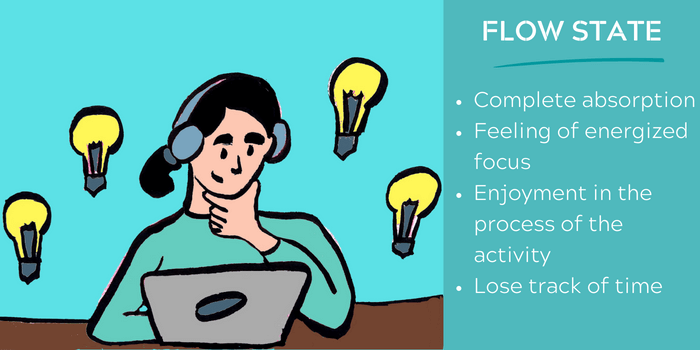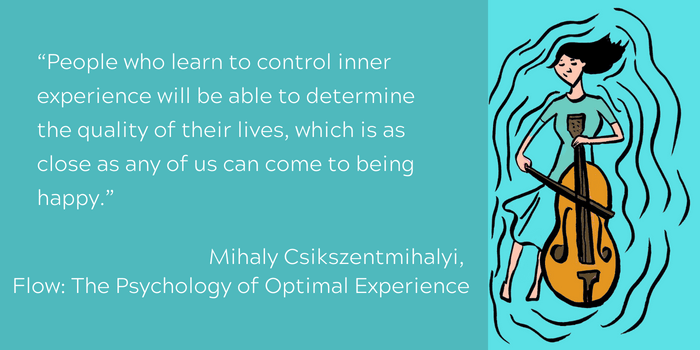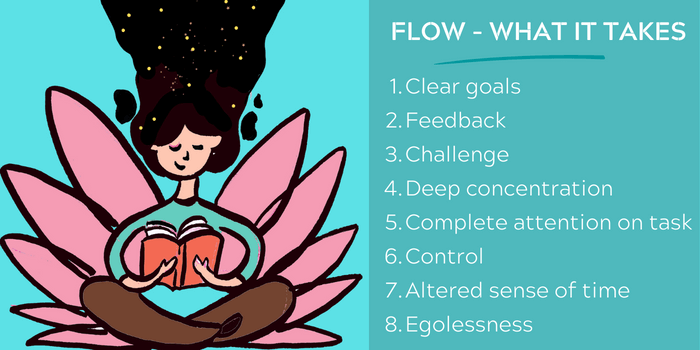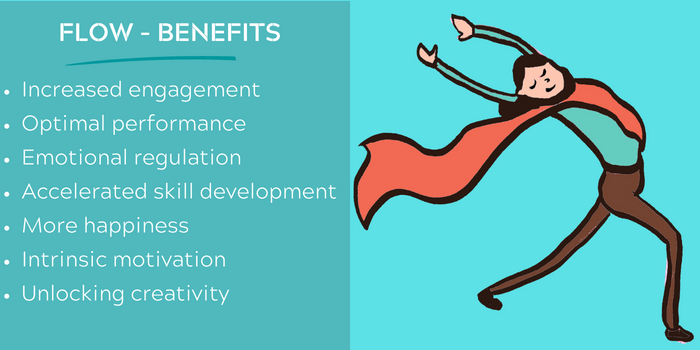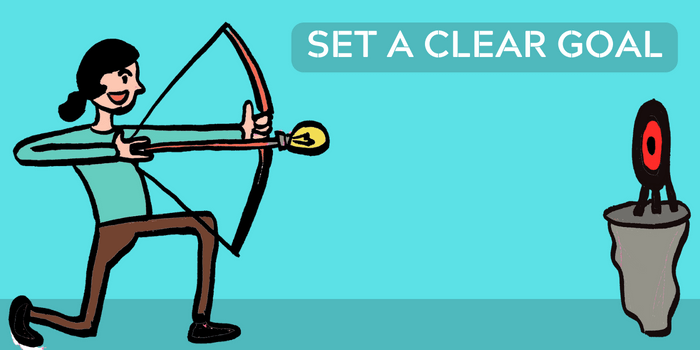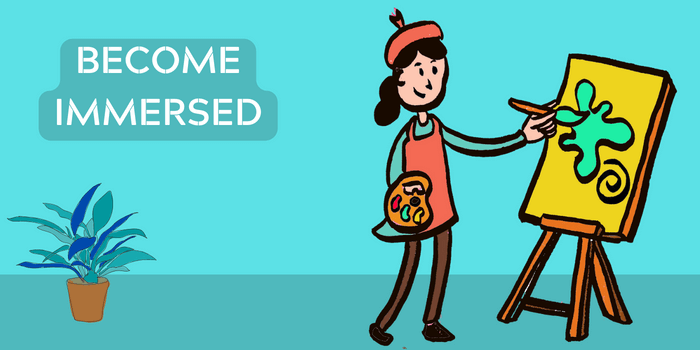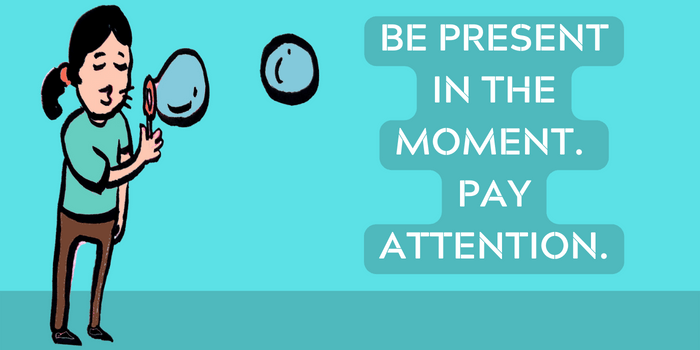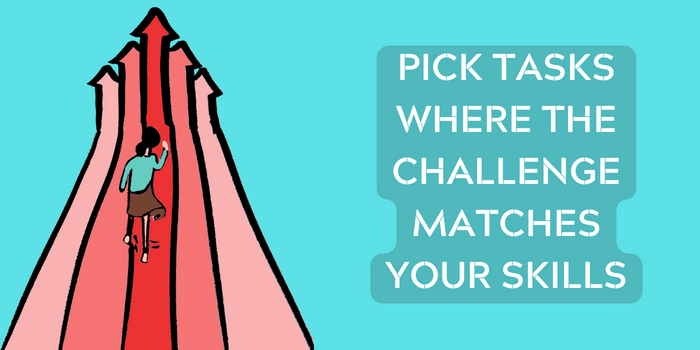During my days as a consultant at McKinsey, when we had clear tasks and tight deadlines, I would sometimes get so absorbed in the task that I would lose awareness of the rest of the world.
This complete absorption in a task is known as the ‘flow’ state.
One common flow experience many of us have is while playing video games – just notice how sometimes people do not even feel hungry and miss their meals — they lose track of time.
When people are totally immersed in whatever they are doing, it is a pleasurable state where they operate at their optimal level — that is called the ‘flow’ state. When athletes are competing in the Olympics or musicians are performing brilliantly, they are often in the flow state.
However, we don’t have to be Olympic athletes to experience flow – we all can experience it in our day-to-day lives. That is what we will talk about today.
What is meant by a flow state?
Flow can be described as the mental state of being fully immersed and engrossed in an activity. A person in a flow state experiences complete involvement and energized focus in whatever activity they are absorbed in.
Being in a flow state is so enjoyable and pleasurable that people sometimes forget the passing of time and even lose track of their own self.
When people are in the flow state, they find the task effortless and often wish that they could just keep going. That is why, Hungarian-American psychologist, Mihaly Csikszentmihalyi, who pioneered the idea of flow, referred to it as the optimal experience.
When athletes are pushing the boundaries of human performance and breaking world records, often they are in the flow state.
Flow state has been researched extensively but the neurocognitive processes of flow still remain largely unclear (1).
One interesting thing to be noted is that being in flow may not always be a good thing. E.g., gamblers are also in a flow state and fully immersed in whatever they are doing! Flow can involve positive or negative activities — it is up to us.
However, when we are in flow while pursuing our goals, we can deliver amazing performance while also enjoying it. And we can all experience flow on a daily basis.
I found the idea of flow so compelling that I launched a ‘Deep Work and Flow‘ bootcamp at my startup HabitStrong, to help people experience flow in their daily life.
How do you get into a flow state?
What does it take to achieve flow? First, let’s look at some flow research.
The psychological concept of flow was recognized and named by Csikszentmihalyi in 1975. He theorized that people are happiest when they are in a state of flow.
8 conditions of flow
Csikszentmihalyi found that whenever people reported being in a flow state, most or all of the following conditions were true:
- Clear goals: People had clear short-term goals
- Feedback: They got instant feedback on what they are doing wrong and how to course correct
- Challenge: The task was not too easy, not too hard
- Deep concentration: People were not distracted — they got totally absorbed
- Task takes complete attention
- Control: They felt full control over the outcomes
- Altered sense of time: They lost track of the passage of time
- Egolessness: They lost self-awareness
According to Csikszentmihalyi, when people are in flow, nothing else matters to them, and they find themselves in an optimal state of intrinsic motivation, i.e., they were enjoying the activity for its own sake. He felt that being completely involved in an activity for its own sake is what led to flow (2),(3).
What are the benefits of flow?
From personal experience, I can tell you that the flow state feels great! If you achieve a flow state while pursuing your goals, you will experience a plethora of benefits. Here are a few:
Increased engagement
While in a flow state, people feel fully involved and engaged in the task they are doing. It is a sort of effortless attention that feels extremely enjoyable and puts you ‘in the zone.’
Optimal performance
Being completely immersed in a specific task can give a massive boost to performance. When you’re able to completely lose yourself in the task at hand, it heightens all aspects of your achievements.
Emotional regulation
People are more likely to experience better emotional regulation with increased flow. The mind gets clearer and calmer. The distractions of the environment fade away and stop bothering you — you just don’t notice them anymore.
Accelerated skill development
Flow happens when we master a skill, and individuals who seek flow are likely to take up new challenges for growth. You feel a better sense of control. This is especially true in the case of athletic activities where the flow state creates an easy fluidity and deeper connection between the mind and body.
More happiness
People in a flow state feel so happy and engrossed that they sometimes even lose track of time! Experiencing flow is an undeniably positive experience. This state of bliss comes from deep within simply because you’re so thoroughly enjoying what you’re doing; it’s not due to any external factors that you have no control over.
Intrinsic motivation
Being in flow is a positive mental state that can lead to more joy and motivation — it enhances performance. The better you perform the more motivated you feel to do even better.
Unlocking creativity
The flow state often happens during creative tasks, and the pleasure of being in flow can lead to effortless creativity. Being able to forget oneself and focus intensely on an activity can unlock levels of creativity that you were previously unable to access.
Tips for getting into the flow state
Would you like to know how to get into flow more often? The good news is that it is easy to get into a flow state once you satisfy most of the eight conditions of flow (discussed above). With practice, you will get better at it.
Csikszentmihalyi laid out a few things that can help trigger flow (2):
1. Set goals that have clear and immediate feedback
Getting feedback immediately while performing a certain task can lead to a flow state. Just to give an easy example, when you are playing a war video game, if your bullet misses the target, you immediately know whether you shot a bit to the left or right. It motivates you to change your aim and try again. That is how the feedback gets you hooked to the game.
For example, let us say you are good at drawing portraits. Now when you are doing a portrait, you intuitively know whether it is coming out well. And if you make a mistake, say the face outline is not done well, you can sense the error. Now you will want to correct it. The act of perceiving your mistake is the feedback.
2. Become immersed in the particular activity
To achieve a flow state, it is important to become fully engrossed in the activity you are performing. The more you care about the task, the more likely you are to get into a flow state.
In video games, this happens effortlessly.
Another example: When you have a deadline that is achievable with a good effort, your mind automatically lets go of other distractions and focuses on the task, creating flow.
However, if you are doing some day-to-day work, it will help to consciously remove all sources of distractions to increase the odds of getting into the flow state.
3. Pay attention to what you are doing at the moment
Being present and mindful about your task goes a long way in achieving a flow state. Irrespective of what you are doing, make a conscious attempt to stay in the moment and pay attention to whatever is happening.
4. Pick a task where your skills equal the challenge at hand
Find a task that is not too easy, or too hard. If it is too easy, you will get bored and your mind will wander. If it is too hard, you will get frustrated and again, your mind will not be fully absorbed.
Choosing the tasks with the right difficulty level will help you get into a flow. Something that is slightly above your current skill level, but achievable, is ideal.
Achieving flow through ‘Deep Work’
Now that you know what it takes to create, I encourage you to start incorporating flow into your daily life. Pick a task and get started.
A lot of times people know the theory but are not able to translate it into practice. Hence, at my startup HabitStrong, we offer a ‘Deep Work and Flow‘ bootcamp, where participants implement these very ideas and practice them six days a week. If you adhere to the instructions, this bootcamp will be a gamechanger.
Is flow hyped?
While being in a flow state definitely has its benefits, I do sometimes wonder, is flow overhyped? To some extent, it is, especially when we make it sound something esoteric and magical.
In my opinion, while flow is no magic, it is surprising how much joy, pleasure, and emotional fulfillment it brings. And yet, it is achievable on a daily basis.
Also, not all tasks lead to the flow state even if you try to fully focus, e.g., if your task is very hard. Yet, it is worth doing those hard tasks. So don’t always look for flow – just enjoy it when you can and when it happens.
Closing thoughts
The concept of flow is truly beautiful. And yet, it is totally accessible to all of us on a day-to-day basis.
How wonderful would it be if we achieved a state of complete absorption in an activity that we’re doing, and felt emotionally fulfilled and happy?
Just try to satisfy the conditions of flow described above and quite often, you can get lost in what you’re doing. Keep on practicing.
References:
- https://www.frontiersin.org/articles/10.3389/fpsyg.2021.645498/full
- https://www.pursuit-of-happiness.org/history-of-happiness/mihaly-csikszentmihalyi
- https://www.ted.com/talks/mihaly_csikszentmihalyi_flow_the_secret_to_happiness?language=en
- Nakamura, J., & Csikszentmihalyi, M. (2009). Flow theory & research. Handbook of positive psychology

